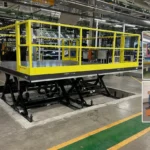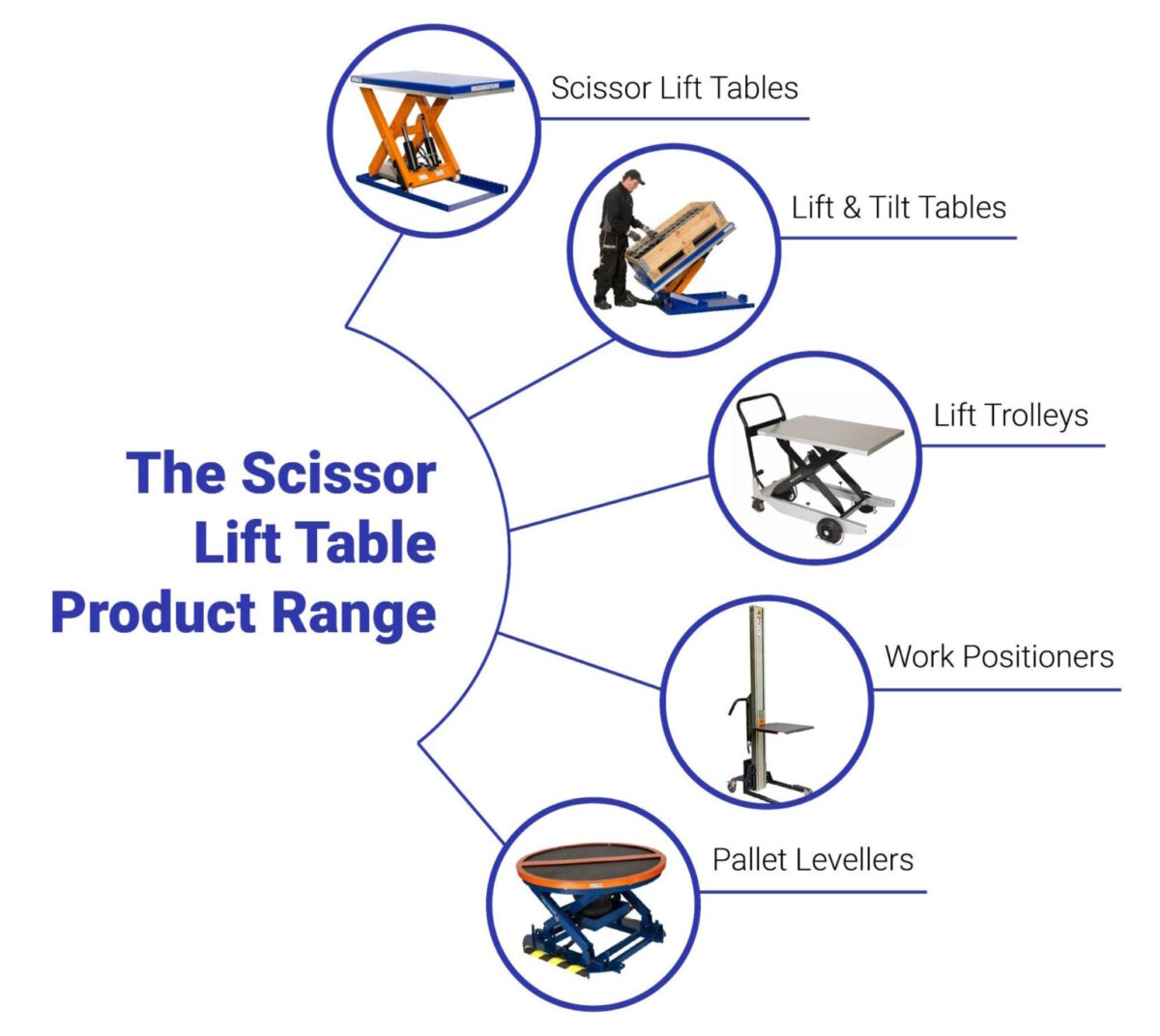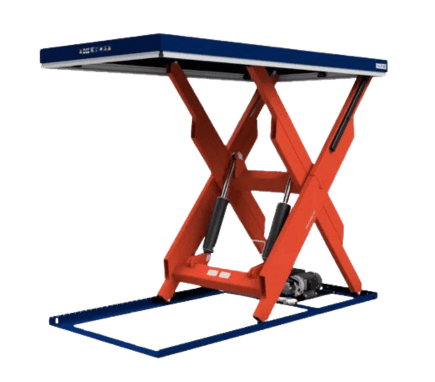
How To Use Your Pallet Lifts To Enhance Workplace Efficiency
May 21, 2025
From Conveyors to Scissor Platform Lifts: Essential Material Handling Equipment for Your Business
May 21, 2025The Evolution of Scissor Lifting Tables
The modern scissor lift table is an innovative piece of machinery designed to reduce strain, increase productivity and overall improve the workplace. They are stationary lifting platforms that are specially designed to raise and lower heavy loads, typically used in settings where a lot of positioning, material handling and line work is involved.
But how did we get to the innovative product we see today? Join us as we delve deeper into the evolution of scissor lift tables.
Humble Beginnings
As long as there has been man, there has been a need to lift. For a long time, this was only accomplished with manual labour and only relied on man-made power for most of human history. But while the need to lift has always been there, so has been the concern with reducing strain on those doing the lifting.
The ancient Egyptians and Mesopotamians are the first we have on record of using lifting equipment, using basic crane-like pulley systems known as shadufs to extract water from the river. The very first cranes recorded for construction use were recorded in around 500 BC by the ancient Greeks, who used them to build many of their temples and structures.
One of the earliest documented lifting devices was designed by Archimedes himself, all the way back in around 230 BC. Commonly known as the Archimedes screw, it was a type of pump that used a rotating screw-shaped blade to lift water from one level to another.
It was primarily used for irrigation applications, and while it did not carry people or goods, it was a significant step forward in terms of lifting devices and paved the way for centuries of development. It was so innovative, in fact, that the Archimedes screw model is still commonly used today.
The Romans built on the ideas of the Greeks to build trispastos, triple pulley systems that significantly improved productivity. After the fall of the Roman Empire, many of these designs were lost, and it wasn’t until the Industrial Revolution that we saw further large strides in development.

The Industrial Revolution
The Industrial Revolution brought with it developments in almost every field, and in the world of lifting tables, this is where mechanical force began to be used. Steam power started to be used more prominently, which could help to power technology and stop it from relying so heavily on human power. In 1835, a belt-pulled lift table called a winch machine was first installed in a British factory, and the first industrial hydraulic lifting tables soon followed, starting in 1846.
Recent Scissor Lift Table Innovations
The concept behind a scissor lift table is a simple and effective one, utilising linked, folding supports in a crisscross pattern that will raise and lower payloads vertically. Since they became widely available, most of the enhancements in the field have been to improve the design, materials, and operational capabilities, which can help to ensure the best and most efficient performance.
One of the biggest developments in the world of scissor lift tables has been the materials used in their construction. Development of things such as high-strength steel alloys and reinforced structures have increased the capacity of scissor lift tables while also maintaining structural integrity. This means they can now handle increased loads without fear of breaking.
There has also been plenty of development to increase the safety of scissor lift tables. This includes emergency stop buttons and non-slip platforms, which can quickly stop the scissor lift table and prevent loads from slipping around and potentially falling off and either breaking or hurting a worker.
Explore Our Scissor Lifting Table Range
Here at Edmolift, we are one of the leading manufacturers of scissor lift tables and other related lifting products, all built in our UK workshop.
We also stock quality lift and tilt tables, ideal for precisely positioning loads of all types with a capacity of up to 1500kg. If you’re looking for something on wheels, our lift trolleys are perfect for warehouses and workshops where you need to lift loads to various spots.
We, are also able to provide reliable work positioners, with a range of capacities, platform sizes and maximum heights as well as pallet levellers to make working with pallets easier and safer.

The best thing about the products available from us is their versatility, helping with everything from making a great adjustable workbench for maintenance to stacking timber at an adjustable height to avoid bending and stretching.
If you’d like to find out more about any of our products, or arrange a purchase, get in touch with us today.
FAQ
What are some different types of scissor lift tables?
Scissor lift tables come in a variety of types, each designed for specific applications based on their mechanism, mobility, and structure.
By Lifting Mechanism:
- Hydraulic Lift Tables: The most common type, these use a hydraulic system to pump fluid into cylinders, raising or lowering the platform. They are known for their high lifting capacity and smooth operation.
- Pneumatic Lift Tables: These use compressed air to operate, which makes them a clean, fluid-free option. They are ideal for environments where cleanliness is critical, such as cleanrooms, food processing facilities, and electronics assembly.
- Manual Lift Tables: Operated by a hand or foot pump, these are typically used for lighter loads and less frequent lifting tasks. They are a cost-effective choice for applications where a power source is not readily available.
- Electric Lift Tables: Powered by electric motors (AC or DC), these tables offer push-button operation for fast and precise height adjustments, making them suitable for repetitive tasks and assembly lines.
By Structure and Mobility:
- Single Scissor Lift Table: This is the most basic and common type, with a single scissor mechanism. It provides a good balance of lifting height and load capacity, and is widely used for ergonomic work positioning.
- Double Scissor Lift Table: These tables have two sets of scissor mechanisms, either stacked vertically or placed horizontally side-by-side.
- Double Vertical Scissor Lift Tables: Designed for greater lifting heights than a single scissor lift, making them ideal for accessing high shelving or transferring materials between different levels.
- Double Horizontal Scissor Lift Tables (Tandem): These have a wider platform to handle long or oversized items that require more surface area and greater stability.
- Low-Profile Lift Table: With a minimal collapsed height, this type can often be installed without a pit in the floor, making it ideal for loading and unloading with a pallet truck.
- Mobile Scissor Lift Table: Also known as a scissor lift trolley, this type is mounted on wheels or casters, allowing it to be easily moved to different locations within a facility.
Static Lift Table: These are permanently fixed in one location and are typically used in production lines or as part of a loading dock system for consistent, heavy-duty use.
What is the difference between a lift table and a scissor lift?
A lift table and a scissor lift both use a scissor mechanism for vertical movement, but their primary purpose and use cases are different. A lift table is a stationary or mobile platform designed to raise or lower goods and materials, often for ergonomic purposes to reduce strain on workers or to position heavy loads for tasks like machine feeding or pallet handling. A scissor lift, on the other hand, is a mobile elevating work platform (MEWP) designed to lift people to a working height, often for construction, maintenance, or other tasks at height.
Do you need a licence for a scissor lift in the UK?
Yes, if you operate a scissor lift for work in the UK, you must receive proper training and hold a valid license or certification. While there isn’t a conventional “driving license” for a scissor lift, the Health and Safety Executive (HSE) requires that all operators of MEWPs are adequately trained. The most widely recognised certification is an IPAF (International Powered Access Federation) PAL (Powered Access Licence) Card, which proves you are competent to operate the equipment. This certification is typically valid for five years before it needs to be renewed.
What is a scissor lift table used for?
A scissor lift table is an adaptable platform used for a variety of material handling and ergonomic applications. Its main purpose is to raise, lower, and position heavy loads to a convenient height for workers. Common uses include:
- Work positioning: Lifting materials to an optimal height on an assembly line or for product inspection.
- Loading and unloading: Serving as a bridge between different levels, such as a loading dock and a truck.
- Pallet handling: Making it easier to access and manipulate goods on pallets without bending or stretching.
- Machine feeding: Raising materials to feed them into machinery at the correct height.




